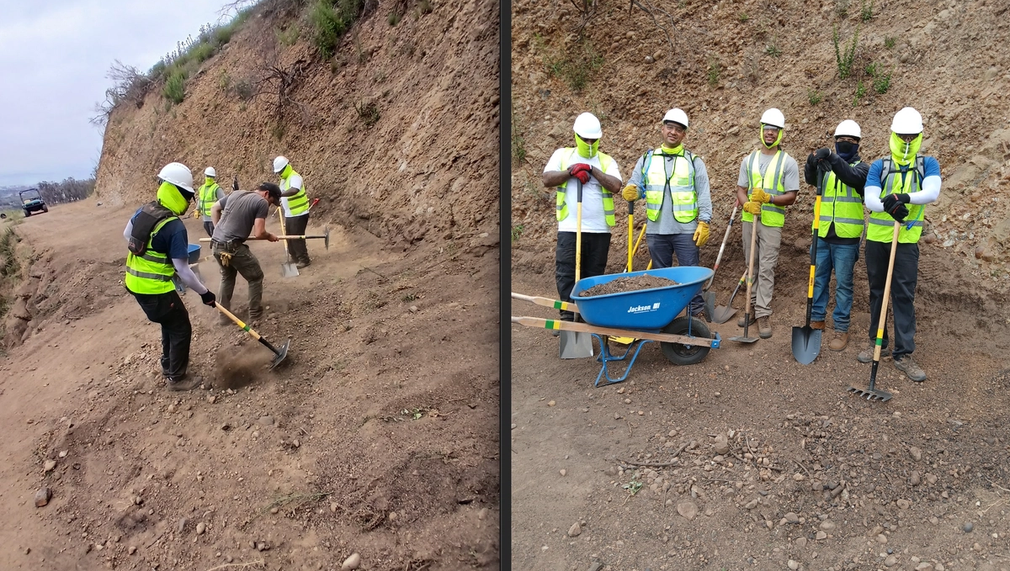Trails to Recovery: From Ashes to Action
Trails to Recovery fosters community collaboration in restoring public recreation spaces damaged by the January 2025 fires. The project will equitably engage residents 18 and older of Altadena, Pasadena, Pacific Palisades, and Malibu in paid trail restoration work. Trails to Recovery will provide hands-on, nature-based learning including trail repair, plant identification and ecological resiliency. The experience will be documented via field photography for visual storytelling. This innovative opportunity provides healing through rebuilding.

What is the primary issue area that your application will impact?
Wildfire relief
In which areas of Los Angeles will you be directly working?
San Fernando Valley County of Los Angeles (select only if your project has a countywide benefit)
In what stage of innovation is this project, program, or initiative?
Pilot or new project, program, or initiative (testing or implementing a new idea)
What is your understanding of the issue that you are seeking to address?
Trails to Recovery addresses two connected issues: Many trails and parks in the Eaton and Palisades burn areas remain closed due to fire damage, suppression activities, and post-fire storms (mud/debris flows). Some closures protect against damage to natural regeneration, other closures are due to the lack of resources dedicated to trail and wild land restoration as well as the multiple, competing priorities of the County's recovery efforts. At the same time, residents are still recovering from the physical, emotional trauma of the fires including loss and displacement. Impacted individuals can benefit from socio-civic engagement that comes with being a part of a dedicated group focused on resilience and recovery. Research in the Journal of Social Psychiatry and Epidemiology shows that strong group connections help wildfire survivors mental health outcomes (Cruwys et al., 2023). Trails to Recovery offers hands-on trail work and nature-based learning to promote healing and resilience.
Describe the project, program, or initiative this grant will support to address the issue.
Trails to Recovery is designed to address the long-term recovery needs in the 2025 fire-impacted areas, focusing on restoring public trails and parks while fostering community healing. The project will clean-up and repair damaged trails, remove invasive plants and restore native plants in order to help to make these beloved and often visited spaces safe and accessible again for public recreation. All restoration work will be led by skilled supervisors with deep knowledge of the local environment and experience completing trail maintenance work. MCS EDC will partner with community organizations such as the Altadena Crest Trail Restoration Working Group and the Chaney Trail Corridor Project.
The project will engage local volunteers that were directly impacted by the fires and offer stipends to acknowledge their participation and labor in the restoration efforts. By providing paid opportunities for community members to participate in meaningful work, the initiative will help individuals process trauma and rebuild a sense of connection to the land and to community. Volunteers will focus on trail restoration, invasive plant removal, habitat restoration through native planting, among other tasks. An Altadena based artist will be commissioned for visual storytelling of the transformation of space, including portraits to be included with post-fire testimonies. Photographs will be shared via the project’s website, social media, and in public displays in local libraries or cafés.
Describe how Los Angeles County will be different if your work is successful.
If successful, LA County will experience a tangible recovery and improvement in both its natural spaces and communities. Our efforts will directly impact those affected by the January 2025 fires by restoring and helping to re-open fire-impacted public trails, greenspaces and provide safe park access. By engaging volunteers from the fire-impacted communities, and paying them a stipend to acknowledge the worth of their time, our project will foster a sense of camaraderie and collective healing by allowing individuals to process loss while actively contributing to the community's recovery. Our aim is also that lessons offered such as trail repair, plant identification and native ecology imparted to participants will become useful and practical for their continued engagement as stewards in the urban-wildland interface of LA County. Through the medium of photography, a historic record of loss and restoration will be curated through visual storytelling to highlight personal narratives.
Approximately how many people will be impacted by this project, program, or initiative?
Direct Impact: 50
Indirect Impact: 350,000